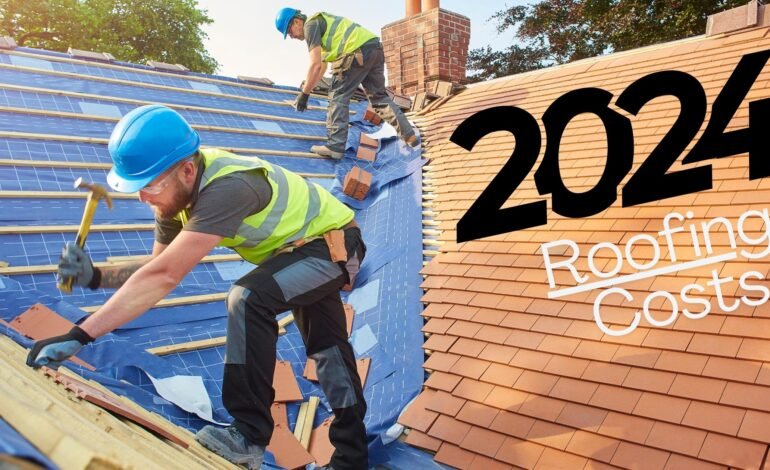Roof Replacement Cost: A Comprehensive Guide for Homeowners in 2024

Your roof is one of the most critical components of your home, protecting you and your belongings from the elements. When it’s time for a roof replacement, understanding the costs involved is essential for budgeting and making informed decisions. This comprehensive guide will break down everything you need to know about roof replacement costs in 2024.
Average Roof Replacement Cost
The average cost to replace a roof in 2024 ranges from $15,159 to $27,580, with most homeowners paying around $21,054. However, roof replacement costs can vary widely based on several factors, including:
- Roof size and complexity
- Roofing materials
- Labor costs in your area
- Removal of existing roofing
- Structural repairs needed
For a typical 1,700 square foot home, you can expect to pay between $6,000 to $9,000 for an asphalt shingle roof replacement. This translates to roughly $3.50 to $6.00 per square foot.
Roof Replacement Cost by Material
The type of roofing material you choose has a significant impact on the overall cost. Here’s a breakdown of average costs for popular roofing materials:
Asphalt Shingles
$5,994 – $9,791
Asphalt shingles are the most common and affordable roofing option. They come in a variety of colors and styles, are relatively easy to install, and typically last 20-30 years. There are three main types of asphalt shingles:
- 3-tab shingles: The most basic and affordable option
- Architectural shingles: More durable and attractive, with a layered look
- Premium shingles: The highest quality with enhanced aesthetics and longevity
Metal Roofing
$9,150 – $16,743
Metal roofs are durable, energy-efficient, and can last 50 years or more. Common metal roofing options include:
- Steel: The most common and affordable metal roofing material
- Aluminum: Lightweight and corrosion-resistant
- Copper: Expensive but extremely long-lasting and attractive
- Zinc: Durable and low-maintenance
Tile Roofing
$8,202 – $24,645
Tile roofs offer excellent durability and a distinctive look. Popular tile roofing materials include:
- Clay tiles: Classic appearance, fire-resistant, long-lasting
- Concrete tiles: More affordable than clay, available in various styles
- Slate tiles: Premium option, extremely durable, can last over 100 years
Wood Shakes and Shingles
$10,230 – $15,500
Wood roofing offers a natural, rustic look and good insulation properties. Options include:
- Cedar shakes: Thicker and more rustic looking
- Cedar shingles: Thinner and more uniform in appearance
Other Roofing Materials
- Synthetic slate: $10,000 – $20,000
- EPDM (rubber) roofing: $4,000 – $8,000 (for flat roofs)
- TPO roofing: $5,000 – $10,000 (for flat roofs)
Factors Affecting Roof Replacement Cost
Several factors can influence the cost of your roof replacement:
Roof Size and Complexity
The size of your roof is typically measured in “squares”, with one square equal to 100 square feet. A larger roof will naturally cost more to replace. Additionally, complex roof designs with multiple angles, dormers, or skylights will increase the cost due to additional labor and materials.
Roof Pitch
The slope or pitch of your roof affects both material quantity and labor costs. Steeper roofs require more safety precautions and are more challenging to work on, increasing labor costs. Most roofs fall between a 3:12 and 6:12 pitch, but anything over 6:12 is considered steep and may incur additional charges.
Geographic Location
Your location affects roofing costs due to:
- Regional differences in labor rates
- Local building codes and permit requirements
- Climate considerations (e.g., additional underlayment in cold climates)
Removal of Existing Roofing
Removing the old roof typically costs between $1 to $5 per square foot. Factors affecting removal costs include:
- Number of layers to be removed
- Type of existing roofing material
- Disposal fees in your area
Structural Repairs
If your roof deck or structural supports are damaged, repairs will be necessary before the new roof can be installed. Common issues include:
- Rotted or damaged decking: $2.20 – $3.00 per square foot
- Sagging roof: $1,000 – $3,000 to repair
- Damaged rafters or trusses: $300 – $800 per rafter
Additional Components
Several other components may need to be replaced or added during a roof replacement:
- Underlayment: $1.50 – $2.10 per square foot
- Ice and water barrier: $1.87 – $2.53 per square foot
- Flashing: $9.00 – $11.00 per linear foot
- Drip edge: $1 – $3 per linear foot
- Ridge caps: $2 – $4 per linear foot
- Roof vents: $50 – $500 each, depending on type
Labor Costs for Roof Replacement
Labor typically accounts for about 60% of the total roof replacement cost. On average, roofing contractors charge between $40 to $60 per hour or $1.50 to $3.00 per square foot for installation. Factors affecting labor costs include:
- Local wage rates
- Roof complexity and accessibility
- Time of year (peak season vs. off-season)
- Contractor experience and reputation
Signs You Need a Roof Replacement
Knowing when to replace your roof can help you avoid costly damage to your home. Look out for these signs:
- Age: Most asphalt shingle roofs last 20-30 years
- Curling or missing shingles
- Granules in gutters
- Daylight visible through roof boards
- Sagging areas
- Water stains on ceilings or walls
- Increased energy bills (poor insulation)
Repair vs. Replace: Making the Right Decision
In some cases, a roof repair may be sufficient instead of a full replacement. Consider these factors:
- Age of the roof: If your roof is nearing the end of its lifespan, replacement may be more cost-effective.
- Extent of damage: Localized damage may be repairable, while widespread issues often require replacement.
- Future plans: If you plan to sell your home soon, a new roof can increase your property value.
The average cost of roof repairs ranges from $400 to $2,000, depending on the issue.
Financing Options for Roof Replacement
Given the significant cost of a roof replacement, many homeowners explore financing options:
- Home equity loans or lines of credit: Use your home’s equity to finance the project
- Personal loans: Unsecured loans based on your creditworthiness
- FHA 203(k) loans: Government-backed loans for home improvements
- Contractor financing: Many roofing companies offer financing options
- Credit cards: For smaller projects or as a short-term solution
Insurance Coverage for Roof Replacement
Homeowners insurance may cover roof replacement costs in certain situations:
- Storm damage: Wind, hail, or fallen tree damage is often covered
- Fire damage: Most policies cover roof replacement due to fire
- Sudden, accidental damage: Unforeseen events may be covered
Note: Normal wear and tear or age-related deterioration is typically not covered by insurance.
Choosing a Roofing Contractor
Selecting the right roofing contractor is crucial for a successful roof replacement. Consider these factors:
- Licensing and insurance: Verify proper licensing and liability insurance
- Experience: Look for contractors with a proven track record
- References and reviews: Check online reviews and ask for references
- Written estimates: Get detailed, written estimates from multiple contractors
- Warranty: Understand both manufacturer and workmanship warranties
DIY vs. Professional Roof Replacement
While DIY roof replacement may seem tempting to save money, it’s generally not recommended for several reasons:
- Safety risks: Roofing work is dangerous, especially on steep or high roofs
- Lack of expertise: Improper installation can lead to leaks and voided warranties
- Time and effort: Professional teams can complete the job much faster
- Equipment costs: Specialized tools and safety equipment are required
- Warranty considerations: Many manufacturers require professional installation for warranty coverage
Tips for Saving Money on Roof Replacement
While roof replacement is a significant investment, there are ways to potentially reduce costs:
- Get multiple quotes: Compare estimates from at least three reputable contractors
- Consider timing: Schedule your replacement during the off-season (late fall or winter) for potential discounts
- Research material options: Balance upfront costs with long-term durability and energy efficiency
- Ask about discounts: Some contractors offer discounts for seniors, veterans, or referrals
- Maintain your roof: Regular maintenance can extend your roof’s lifespan and prevent costly repai
A roof replacement is a significant investment in your home’s protection and value. By understanding the factors that influence costs and making informed decisions about materials and contractors, you can ensure a successful and cost-effective roof replacement project. Remember to prioritize quality and long-term durability over short-term savings, as your new roof will protect your home for decades to come.




